The Worms Are Dancing!
An integrated learning experience with preschoolers
Science and Children—April/May 2019
By Alissa Lange, Lynn Lodien, and Anna Lowe
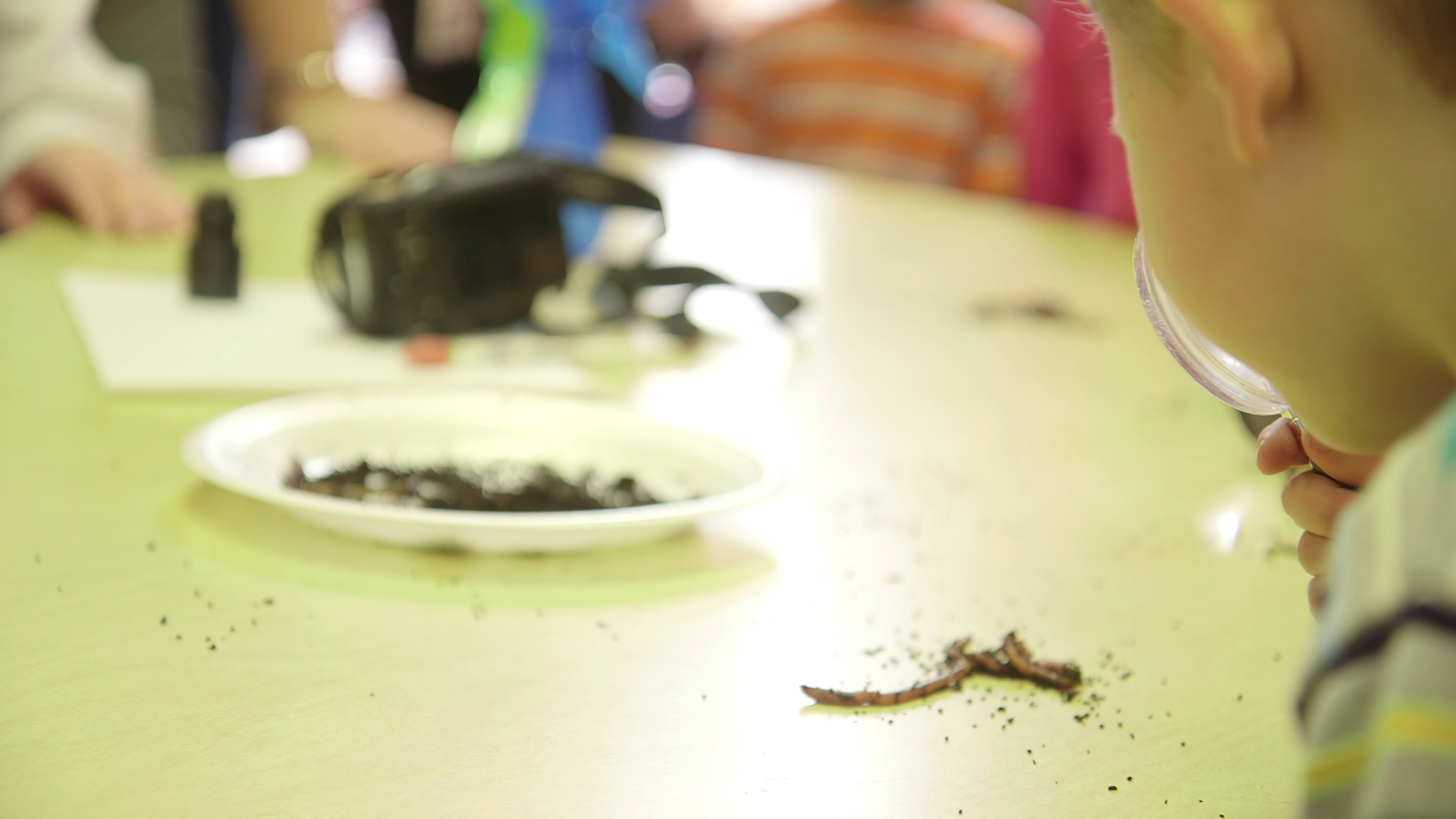
An integrated learning experience with preschoolers
A preschool child gently tries to pick up a worm from the table. Upon being touched, the worm leaps, twists, and curls itself into a spiral shape before stretching back out on the table and squirming around some more. The children sit back and watch the worms’ movement on the smooth surface in amazement. One child shouts with surprise, “They’re dancing!”
In this preschool classroom, children had been studying worms prior to a visit by real worms. Worms dancing was not one of the facts that the children had explored in books and in discussions in the weeks prior to the worm visit. They learned about the bodies of worms and that they do not have bones. The children learned vocabulary words such as segments. They documented thoughts and predictions about worms using drawings. Preparing for this worm experience, the children in this preschool class thought about, talked about, and did hands-on activities across the curriculum about worms.
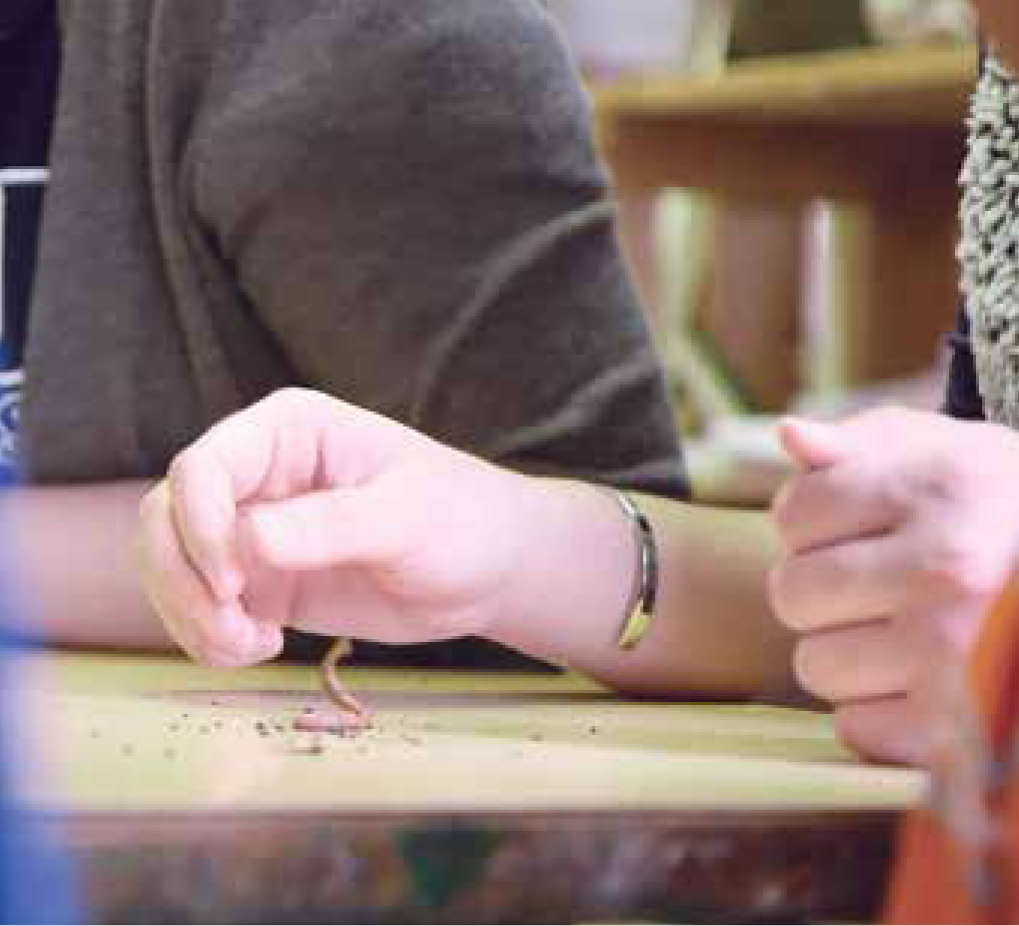
The worm invasion arose from a collaboration between an early childhood professor, a preschool teacher, and undergraduate students (hereinafter “students”). The worm experience was part of a larger project to create an integrated unit of study that covered science, math, literacy, and other domains that used the 5Es framework (see more about the 5Es in the December 2017 issue of Science and Children). The preschool children (hereinafter “children”) explored some new wiggly friends, asked questions reflecting their wonderings, and documented observations.
Preparation
The teacher had spent time preparing the children for the worms’ arrival. She read books (see Resources), the class discussed worms and their habitats, and the children learned that worms had segments as well as how the worms support the life and health of plants. The teacher kept a record of points of interest for the children so she could bring them up during the hands-on worm experiences.
The teacher assessed their knowledge of worms using a “circle of knowledge” assessment. Prior to reading, the teacher asked, “What do we know about worms?” The children told her, and she wrote this on chart paper in one color marker. After reading about worms and doing research online, they went back to the chart and asked again, “Now what do we know?” The teacher wrote in a new color this time to show what they knew then. A key linked the date of the ideas to a particular color ink. The chart quickly showed children’s thinking over time and documented change from before to after a particular experience.
Have children wash hands before and after working with worms. Talk to children about handling the worms carefully and gently so they don’t get hurt. They should be careful not to squeeze them because they are fragile.
The Worms Arrive
The professor and her students brought real and fake earthworms to the class, along with spray bottles, worm food, and soil (bought real worms at Walmart for $3 and fake worms for $7). The children observed with their eyes, with magnifying glasses, and with their fingers and noses. Children demonstrated curiosity (engaged with this experience for over 20 minutes), asked their own questions to test (e.g., “Why does the soil stick to the worms’ bodies?”), and tested their hypotheses (e.g., “If I put it on the plate, maybe it won’t dance around so much”). Teachers asked open-ended questions, such as, “How can you tell they are alive?” and asked the children to state similarities and differences between living and non-living objects (comparing). Children began to notice that some worms were moving on their own while others weren’t, even though they looked very similar.
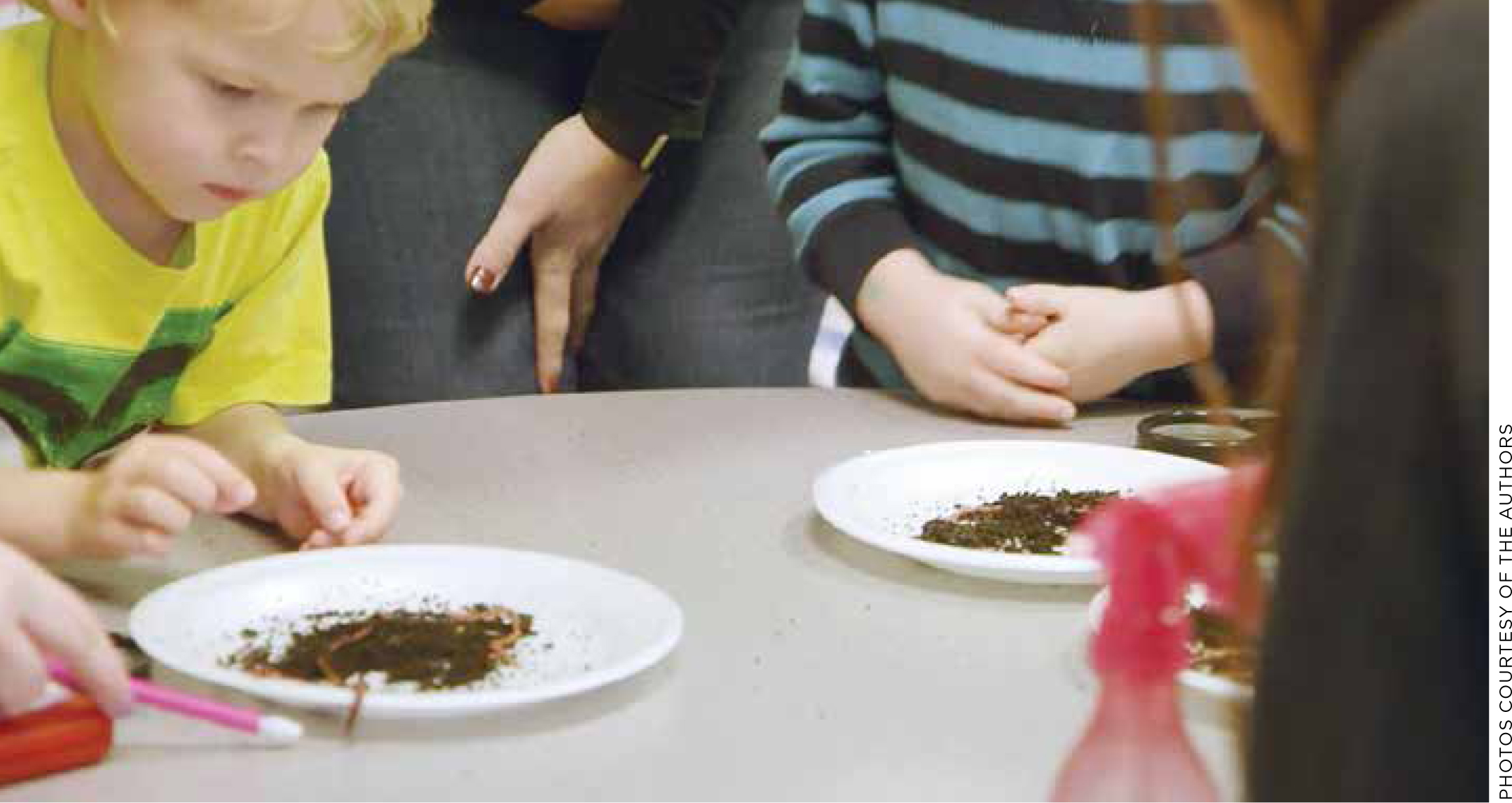
Literacy and Representations
During their hands-on explorations, the children recorded observations by drawing and writing. One child’s drawing reflected segments he saw. When asked how he knew what the segments were, he stated that his class has been learning about worms all week. In the books they read, they saw that the segments helped worms move. He also documented his observations of the shapes of the worms, including tracing one of them! It was his idea to use this strategy to help him represent what he saw. When other children saw this, they also wanted to trace. Children were excited to document what they observed.
The teacher thought it important that children have many chances to re-draw (or re-represent) an event or concept. She views these repeated chances as opportunities for reflection. When children had the chance to revisit, they showed increasing complexity in their representations. For example, starting with just lines to represent worms to two-dimensional drawings showing segments. This was also a chance for formative assessment as the teacher could identify children who recognized that worms have segments. Some children were able to copy the word worm on the paper, while others documented their observations and experiences in drawing.
The teacher chose books that had real images when she could, such as It’s a Good Thing There Are Earthworms by Jodie Shepherd (2014). She felt it was important to include books with real pictures so that children could experience multiple representations of objects and so that children could build their understanding of these types of non-fiction texts. In addition, she felt it was important for children to see worms as they really are to facilitate children building accurate understandings of nature.
Science Studies
Through reading, children explored worms’ habitat and what they need to survive. They learned that worms live in the soil and that it has to be damp. Each child helped prepare the habitat by putting in soil and by spraying it every day with a spray bottle. The students had a good understanding of how to prepare the worm habitats from books they had read throughout the week and through continued discussion with the teacher and peers as they maintained the habitats. They also used their background knowledge and experiences of past units on bugs where they explored their lifestyles while creating a habitat for them. They placed the worms on top of the soil and took turns sprinkling worm food and spraying water inside of the habitat. In the days and weeks following the introduction, children put food scraps into the tank. They noticed that the food was gone a little later. The teacher asked where they think it went and children decided that the worms had eaten the food. Children discussed how worms have to eat, just like people do.
Later, some of the children taped pictures they had drawn to the outside of the habitat so the worms would have something to see. During the experience, children also thought about concepts around living and nonliving. Rubber worms looked a lot like real ones, but they did not move in the same way. Once children had experience with real and fake worms, they were able to point out what was real and not real in storybooks about worms (e.g., worms can’t really write!).
This experience touched on Earth and space science. Children discussed what it was that the worms were living in. Was it dirt? Soil? Sand? How do we know? They also made some connections to physical science. Children discussed how the surface on which the worm moved might impact its movement. The table was smoother than the plate. Was the table colder? Would it dance on their hand, too? They were wondering if the worm could go off the edge of the plate. The teacher asked, “How can we find out?”
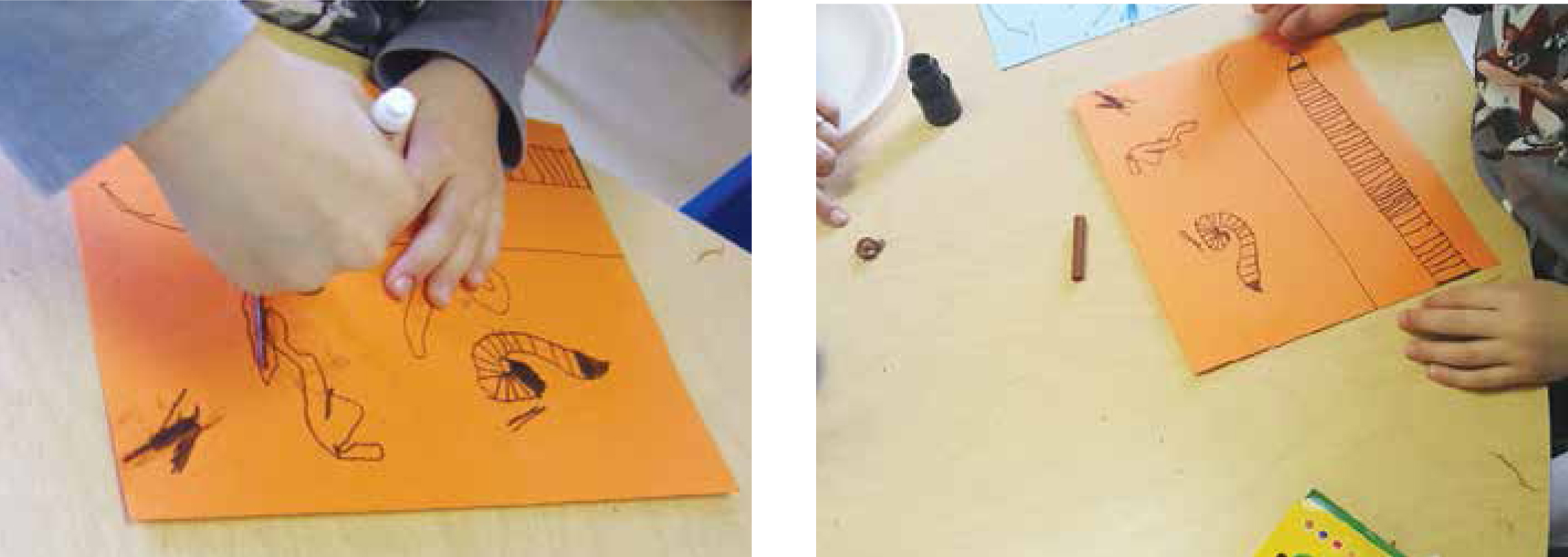
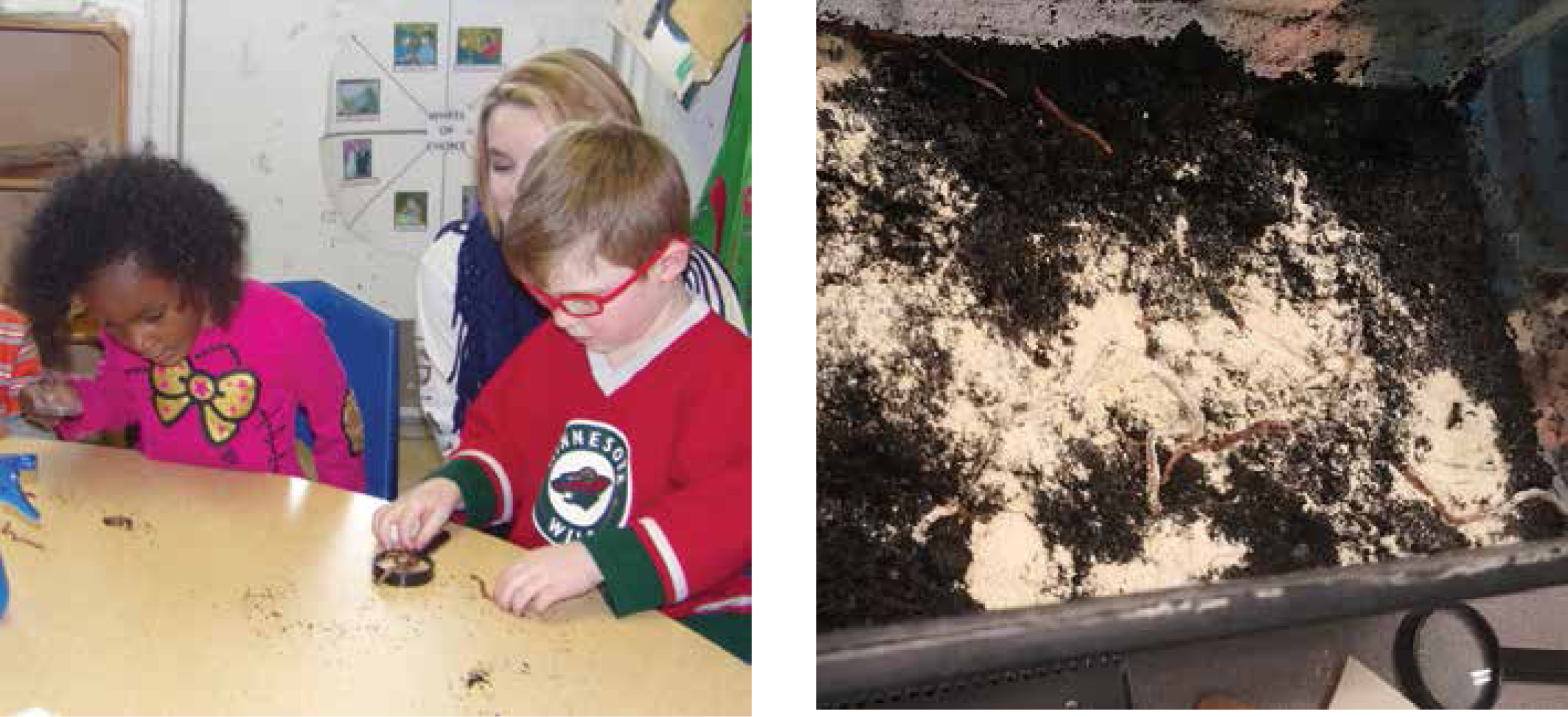
Math Connections
As they observed, children noticed and discussed shapes and lengths of the worms. They used math comparison terms, such as longer and shorter. Teachers brought in shapes to compare the worms to, such as rectangle, oval, and spiral. Children tried to count segments. Because they were tiny, it was hard, but they still tried. The children noticed patterns in the segments as they explained that worms’ segments go from “big to small and back to big.” Another child drew two lines to represent two worms she observed.
Children used technology to look up sizes of worms and found that there is a giant earthworm that can grow to 3 feet long! To continue thinking about measurements of living things, they read related books, such as The Lifesize Animal Opposites by DK (1994) and Actual Size by Steve Jenkins (2015).
Using Technology
Children used magnifying glasses to observe the segments of the worms. First, teachers modeled using a magnifying glass. They held the tool close to their eye and moved it toward the worm. Teachers encouraged children to notice how the magnifying glass made the worm look bigger, or magnified it. Some children hadn’t used one before, so this experience was a motivating chance to do so. Children were very curious about whether or not they could see the segments and the tiny hairs. They couldn’t see the hairs, but they could see the segments.
The teacher used media on a computer to find information about worms, including a giant earthworm. She looked for sources that were reliable, such as the BBC and David Attenborough, and those that were short and accurate (see Resources).
Social-Emotional
The teacher did not anticipate the amount of screaming and jumping children would do each time a worm moved. The children that she thought would dive right into the experience were as hesitant as everyone else. Some children asked, “Will they bite me?” She was surprised by the level of anxiety in the room. In order to help the children become more comfortable, the teacher asked, “Do they have teeth?” Children confirmed that they did not have teeth, but they did have mouths. Worms ate through their mouths, but they probably wouldn’t bite them because they don’t have teeth. The teacher asked if having a mouth was like us or not like us. Then, she held a worm in her hand carefully and asked the children who were nervous to put their hands under hers. That way, they were near the worm, could feel that she was fine when she held it, and it helped them slowly get more comfortable with the idea. A couple children who did not want to touch the worms initially moved on to hold one themselves.
To encourage safe and gentle worm holding, the teacher modeled the appropriate method. She showed how they had to wash hands before touching the worms and how to pick them up carefully with their fingers so they didn’t get squished. The teacher would say, “Look, do you see how I am holding the worm? Can you try holding the worm this way?” The teacher gently picked up a worm between two fingers and then held the worm on her flat hand. She connected taking care of one another with taking care of worms.
What Next?
During the experience, the teacher recorded some things that surprised the class: (1) worms don’t have any teeth, (2) worms have hairs on each of their segments, which are tiny, hard-to-see bristles called setae that help them move through the dirt and, (3) worms breathe through their skin. Although some of these ideas came out of discussions before the worms arrived, many concepts didn’t truly come to life for children until after the experience. Children better understood how worms move and their segments when they were able to see them up close. The teacher assessed these during the activity by asking questions, such as, "Do worms have teeth?" and by returning to her “circle of knowledge” graph. Children learned about the setae before the experience. Although they couldn’t see the hairs during the experience, they did see the worms lengthen and contract. When the children were preparing the habitat, they remembered that the worms need to breathe too (just like people do!), so they should make sure there is air in the tank.
After the worm experience and the fact that children saw them grow and get longer, children began to wonder about the life cycles of bees, caterpillars, and butterflies. The teacher brought in a butterfly tower kit. Over time, children noticed that the caterpillars’ size changed. They noticed that caterpillars were about the length of the fingernails when they first got them, but they got bigger as they ate. The butterfly tower kit included information to support instruction, such as after the caterpillar attaches to the butterfly tower the children should look for its body to form the letter J indicating metamorphosis is about to begin (literacy). Children who didn’t know that letter before knew it by the time they released the butterflies! The teacher often brings in songs that relate, such as Herman the Worman (see Resources for links).
Providing children more experience with worms and other creatures in the days, weeks, and months that followed allowed them to dig deeply into these ideas across the curriculum. This time seemed to make children more comfortable with creepy crawlies. Children began routinely observing insects and other creatures while playing outside. With teacher supervision, worms and insects were collected for more in-depth observation. They found a grub outside on a piece of wood, and they said it was a fat worm, leading to a discussion and comparisons of worms and grubs. Children then made observations such as, “Wow, I didn’t know grubs eat as much as the very hungry caterpillar!”
We learned that when children are comfortable around something, they can begin to investigate beyond the basics. We also learned that hands-on experience as part of a collaboration such
Summary
We learned that when children are comfortable around something, they can begin to investigate beyond the basics. We also learned that hands-on experience as part of a collaboration such as ours benefitted everyone involved. The student coauthor has been able to use this experience in her yearlong field placement to support her mentor teacher with newly mandated integrated lesson plans. Children benefitted because they were excited to explore the materials and concepts deeply, over months. They excitedly shared new words they learned with their parents. Teachers benefitted from being able to mentor preservice students and from having new materials brought in by the project that extended possibilities in their classrooms.
The kind of science, technology, engineering, and math (STEM) experiences that young children have really matters for their later learning (McClure et al. 2017). This project illustrated how rich early STEM experiences don’t have to have fancy materials. With some thought and preparation, a preschool observation and deep dive science experience can lead to incredibly rich language, literacy, mathematics, musical, and scientific thinking and doing that can last for months (or years).
Environmental Science Life Science Early Childhood Pre-service Teachers Preschool


